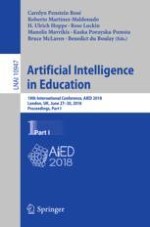2018 | Book
Artificial Intelligence in Education
19th International Conference, AIED 2018, London, UK, June 27–30, 2018, Proceedings, Part I
Editors: Carolyn Penstein Rosé, Roberto Martínez-Maldonado, H. Ulrich Hoppe, Rose Luckin, Manolis Mavrikis, Dr. Kaska Porayska-Pomsta, Bruce McLaren, Benedict du Boulay
Publisher: Springer International Publishing
Book Series : Lecture Notes in Computer Science
